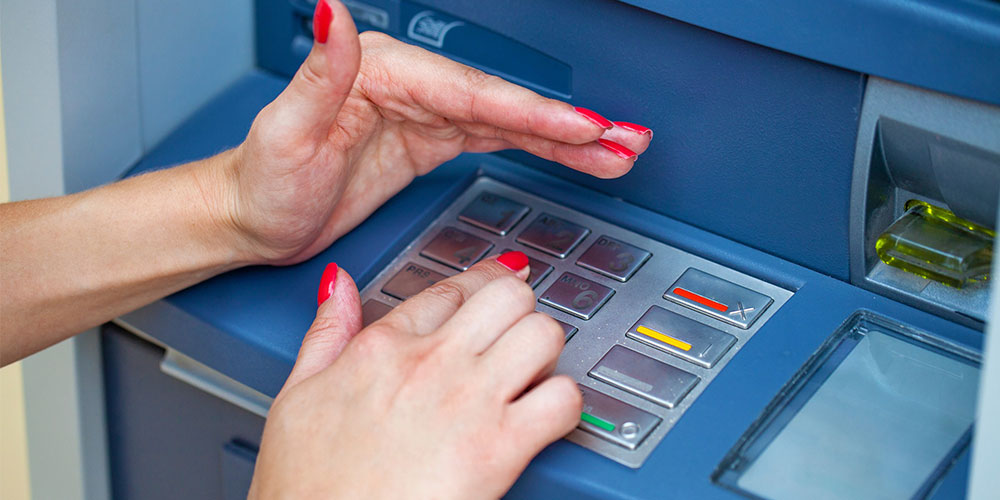
How often do you reach for cash when making a purchase? For most Americans, it’s not often, and the bigger the purchase, the higher the chance of using a card.
According to a recent survey from Forbes Advisor, 91% of American transactions are made with a credit or debit card. Fraudsters are aware of these statistics, too. You can prevent an interruption in your ability to make important purchases by safeguarding sensitive card information. This includes reporting a lost or stolen card to your financial institution immediately. Yet, even if the card stays in your possession, there are ways that your card information can be used fraudulently.
Let’s revisit two of these criminal practices, one old and one new. When you understand these techniques, you can be your own superhero and stop fraud before it happens.
Skimming
Criminals use the skimming technique to steal sensitive data, including credit or debit card numbers, PIN codes, and more. Though it has been around for over 20 years, it’s still one of the most common types of card fraud.
Skimming typically occurs when a physical device, known as a skimmer, is placed on or near a legitimate card reader. That could be an ATM or a point-of-sale (POS) terminal at a store or gas pump. The skimmer is designed to capture card data. An additional component, like a hidden camera or keypad overlay, records PIN codes or other information about the transaction. Even with chip cards, many terminals still use the card’s magnetic stripe in addition to or instead of the chip.
There are some transactions that aren’t subject to skimmers. One is a transaction where you don’t insert your card past the chip, so the magnetic stripe isn’t readable. The other is Tap-to-Pay transactions. Tap-to-Pay is a more recent technology that allows a cardholder to physically tap the card on the device. This uses short-range wireless card reader technology to access the account, rather than relying on the card’s physical attributes.
Protect Your Information
Examine the card reader carefully. When using an ATM, or a POS terminal at a store or fuel pump, look for anything that appears odd. Fraudsters may attach a skimmer directly over the card slot or PIN pad. The result is something that isn’t the same color or shape or that looks bulky. Other signs of tampering include scratches, glue residue or a loose-fitting card slot (touch it to see if it moves). If anything seems suspicious, avoid using the machine and report it immediately.
Use your hand to shield your PIN. You may have developed a habit of shielding the keypad when entering your PIN code at the grocery store. What about when you are alone at an ATM or gas pump though? This should be a habit every time you enter your PIN, no matter where you are. Criminals often install tiny cameras to capture your PIN as the skimmer captures the information from your card.
Use secure and trusted devices. Whenever possible, use ATMs or payment terminals that are in well-lit, secure areas. When filling up, choose pumps close to and within sight of employees. Skimmers must be installed by someone, and criminals will choose areas where they are the least likely to be noticed.
Monitor your accounts regularly. Review your bank statements, credit card statements, and transaction history for any unauthorized or suspicious activity on a regular basis. Report any discrepancies to your financial institution immediately.
Gluing or "Glue-and-Tap"
Gluing, or Glue-and-Tap, is a relatively new method that criminals are using at ATMs to access your bank account directly. This allows them to skip the need for your card information altogether.
This scam typically occurs at a free-standing ATM in a well-trafficked area where people approach on foot. The perpetrator pours glue into the card reader. Sometime later you visit the ATM to retrieve cash, but you find that you can’t insert your card. A seemingly helpful bystander says the machine is jammed, but you can still make a withdrawal by tapping your card. At that point, you tap your card (or phone), enter the PIN, and leave, often even thanking the “helpful” stranger. The bystander is counting on you not being familiar with the extra step required for this type of withdrawal.
When a card is inserted, the account window closes after the card is removed. A tap transaction must be closed out on the screen before you leave the ATM.
The fraudster expects the victim to be unfamiliar with the process and can drain the account that was left open. Some victims even report being uncomfortable due to the bystander's presence. Distracted by efforts to leave quickly and safely, they leave their account window open, even if they know better. Scammers recently utilized this method during a series of incidents in San Francisco, which was featured in a news report.
To protect yourself, avoid any ATM with a card reader that doesn’t work properly. If you use the tap feature on your phone or card, always wait for the prompt asking if you’re finished. Then confirm that your account is no longer accessible before leaving.
We’re Here For You
It's up to all of us to stay protected against identity theft, particularly in the case of payment card fraud. If a criminal gets your payment card, they may not stop there. If you feel you may be a victim of identity theft, we’re here for you. We have professionals standing by to help you get your life back on track.
If you have a Smarter, Smart or Fresh Start checking account, review and activate your monitoring benefits with NXG Protect. This will help you stay informed of any activity that could indicate you are a victim of identity theft.

